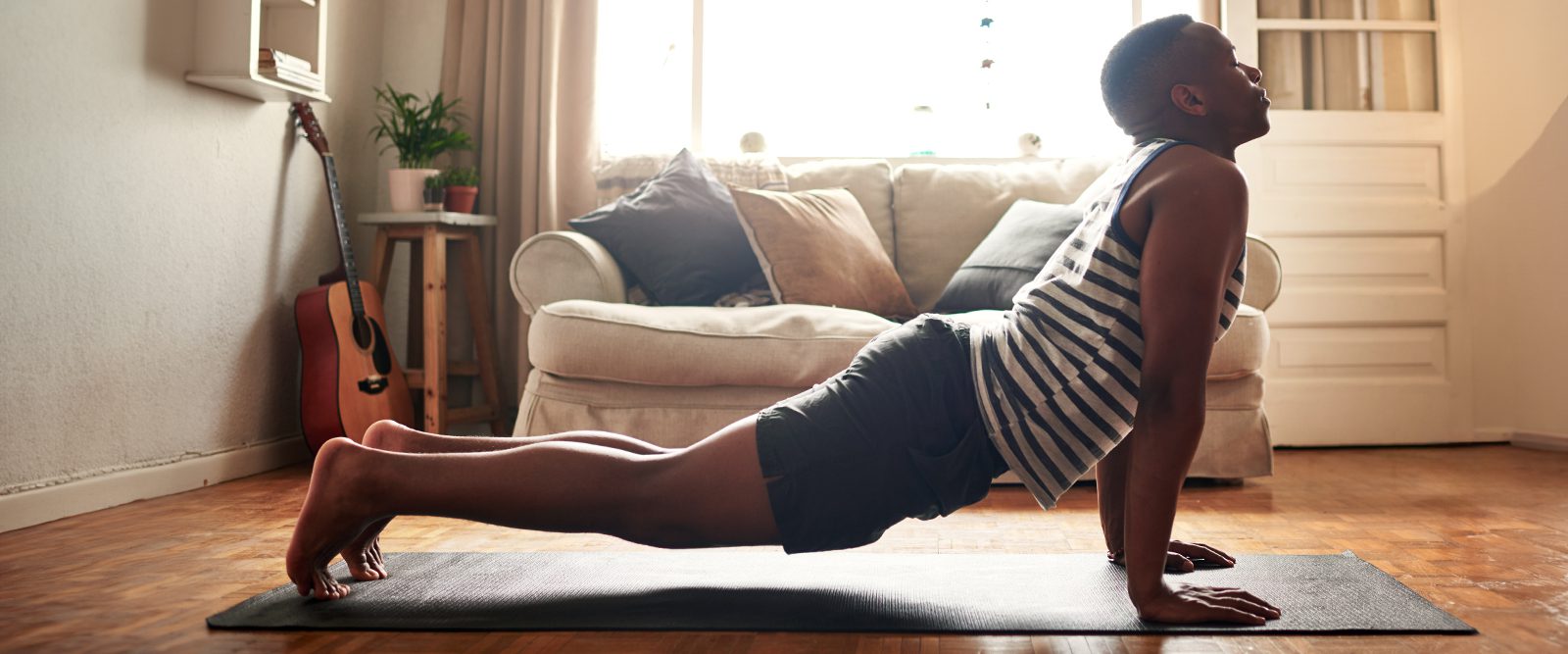How Cozy Cardio Can Fit Into Your Fitness Routine
A cardiologist explains how the benefits of the at-home, low-impact exercise trend extend beyond physical fitness.

When you think of cardio exercise for your heart health, watching your favorite show in your pajamas may not be the first scenario that comes to mind. Enter cozy cardio.
While more intense aerobic activities like running or cycling are still important for helping strengthen the cardiovascular system, the trend of “cozy cardio” workouts has gained popularity on social media, highlighting how people are combining exercise with a relaxed environment.
“In a nutshell, these are low-impact exercises that raise your heart rate in a comfortable setting like your home,” says Dr. Jessica Hennessey, a cardiologist at NewYork-Presbyterian/Columbia University Irving Medical Center. “Whether that’s using a walking pad while watching a movie or doing vinyasa yoga in your living room, you don’t need to set anything up or even change your clothes. It opens exercise to everyone, incorporating an important mental component of a relaxing, intentional, self-love practice. Think of it as something in your toolbox of exercise: it can be your warm-up, cool down, or your workout for the day.”

Dr. Jessica Hennessey
So what exactly is cozy cardio and how can it fit into your daily routine? Dr. Hennessey shares more with Health Matters on its benefits and how to make workouts a little cozier.
Cozy cardio allows you to ease into a new regimen on your terms.
Cozy cardio took off on TikTok and Instagram, with audiences relating to the idea of making exercise less intimidating and more accessible.
If you’re new to fitness or making a return, a gentle routine can be helpful.
“Some patients may have issues with their joints, wrists, or knees, in which case hardcore, endurance exercises aren’t going to be the way they get that cardiovascular benefit,” says Dr. Hennessey, who is also the Esther Aboodi Assistant Professor of Cardiology (in Medicine) at Columbia University Vagelos College of Physicians and Surgeons.
Cozy cardio can also be an option to build fitness into a busy schedule.
“If you get out of work late at night, you could still exercise at a time that works for you, as long as it’s not negatively impacting your sleep or eating habits,” she says.
Exercise doubles as self-care time.
“We exercise for a lot of reasons, but the mental health aspect should be a big part of it,” says Dr. Hennessey. “If you can create an environment where you look forward to exercise, the benefits aren’t just physical.”
Carving out dedicated time to combine physical activity with something you already associate with self-care — like listening to music, enjoying nature, or a new TV series — can provide additional motivation.
For some people, home is a better environment for exercise. “People can have gym anxiety — they might be worried about judgment around their form, how much weight they’re lifting, or being exposed to viruses. Cozy cardio eliminates those barriers.”
Intense, high-endurance workouts or group exercise classes may not appeal to everyone, so being mindful of an ideal space to get yourself moving is key.
‘Exercise snacks’ and low-impact exercises can help you meet your weekly activity goals.
The American Heart Association (AHA) recommends at least 150 minutes per week of moderate-intensity aerobic activity, or 75 minutes of vigorous aerobic activity. For moderate-intensity aerobic activity, aim to reach 60 to 70 percent of your maximum heart rate for your age (calculate your maximum heart rate by subtracting your age from 220).
“Cozy cardio can be seen as a Zone 2 type of exercise based on the heart rate zone, with Zone 1 being a place where you can easily hold a conversation and Zone 5 where you can’t talk at all,” Dr. Hennessey says.
One way to reach your weekly goals is by during more short bursts, also called exercise snacks. A recent study from Columbia University found that taking a five-minute walking break every half hour can help lower blood sugar and blood pressure.
“If you got up and walked around for five minutes after every 30-minute episode, you can get a cardiovascular benefit. During each commercial break, do some wall sits,” she says. “There are little ways to work it into your day.”
Another way to do exercise snacks are through isometric exercises, which involve contracting muscles while holding one position. “When you’re holding one position for a period of time – think wall sits, planks or yoga poses – you can help lower your blood pressure,” Dr. Hennessey says.
Cozy cardio helps incorporate variety into your exercise routine.
The AHA recommendations include four categories of exercise in a weekly routine: endurance, strength, balance, and flexibility. Integrating cozy cardio with some stretches or yoga can help establish a healthy variety of physical activity.
“Each day doesn’t have to have the hardest workout of your life,” Dr. Hennessey says. “If you know your day will be long at work, you can incorporate cozy cardio in the early morning and focus on balance or flexibility.”
If the gym is part of your daily routine, a relaxed workout on your rest day can be beneficial, helping to avoid injury and stretch your muscles.
Cozy cardio can also be a workout option during vacation, Dr. Hennessey says.
“My version of cozy cardio is bringing my mat to the beach and doing yoga for 20 minutes in the morning before my kids wake up,” she says. “I’m on vacation, but I’m in this beautiful place and I get to enjoy it while getting a little bit of exercise. The beauty of it is you can do it anywhere.”
4 Cozy Cardio Exercises To Try
1. Indoor or Outdoor Walk
Grab a glass of your favorite healthy drink, turn on a movie, and log some miles on a walking pad indoors. Or go for a walk around your neighborhood for 10 to 15 minutes at a brisk pace.
2. Cardio Dance
Turning on a fun, online dance class at home can get you moving — and help you reach 60 to 70 percent of your maximum heart rate while being low impact on your joints.
3. Vinyasa Yoga
Moving in sync with your breath during vinyasa yoga provides an opportunity to center yourself. With each movement creating a flow preceded by a breath in or out, you are constantly in motion and increasing your heart rate. Starting with sun salutations is a great beginner example, Dr. Hennessey says.
4. Mat Pilates
It may be harder to cozy up with a cup of coffee during mat Pilates, but you’ll be sure to work on your flexibility and self-awareness. While holding movements, you’re teaching your heart to be more efficient with each beat, according to Dr. Hennessey. The Hundred, a classic Pilates exercise, can be a more vigorous option. Variations of planks, such as elbow planks, side planks, or shoulder taps are helpful to strengthen your core.
Jessica A. Hennessey, M.D., Ph.D., is an electrophysiologist who specializes in arrhythmia management with a special focus on catheter ablation, pacemakers/defibrillators, and atrial fibrillation at NewYork-Presbyterian/Columbia University Irving Medical Center. Dr. Hennessey is also the Esther Aboodi Assistant Professor of Cardiology (in medicine) at Columbia University Vagelos College of Physicians and Surgeons. She is board-certified in cardiovascular disease and cardiac electrophysiology.
Additional Resources
Learn more about managing and preventing heart disease.
Learn more about comprehensive cardiovascular care at NewYork-Presbyterian.
